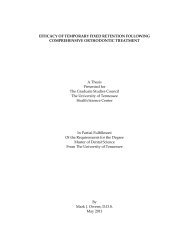Brandi M. Baughman Abstract - ETD Index Page
Brandi M. Baughman Abstract - ETD Index Page
Brandi M. Baughman Abstract - ETD Index Page
You also want an ePaper? Increase the reach of your titles
YUMPU automatically turns print PDFs into web optimized ePapers that Google loves.
<strong>Brandi</strong> M. <strong>Baughman</strong><br />
Document Type:<br />
Name:<br />
Email Address:<br />
Title:<br />
Degree:<br />
Major:<br />
Program:<br />
Track, if Integrated Program in Biomedical<br />
Sciences:<br />
Research Advisor:<br />
Advisor's Email:<br />
Committee Members:<br />
Keywords:<br />
Availability:<br />
Doctoral Dissertation<br />
<strong>Brandi</strong> M. <strong>Baughman</strong><br />
<strong>Brandi</strong>.M.<strong>Baughman</strong>@gmail.com<br />
Structural Identification and Applications of<br />
Novel Fluorescent Probes in Chemical Biology<br />
Doctor of Philosophy<br />
Integrated Program in Biomedical Sciences<br />
Molecular Therapeutics and Cell Signaling<br />
Thomas R. Webb, Ph.D.<br />
twebb13@uthsc.edu<br />
Donald Bashford, Ph.D.<br />
Richard Lee, Ph.D.<br />
Stephen White, D.Phil.<br />
Jie Zheng, Ph.D.<br />
Endonuclease, Fluorescence, Influenza<br />
World-Wide Web Access<br />
Graduation Date: December 2012<br />
<strong>Abstract</strong><br />
Fluorescence spectroscopy is one of the most widely used tools in drug discovery; however,<br />
specific criteria for compound fluorescence are not well defined. While a highly sensitive<br />
method of detection, fluorescence-based sensing is susceptible to assay interference due to<br />
intrinsically fluorescent compounds. Current methods of fluorescence prediction do not consider<br />
high-throughput screening (HTS) requirements and therefore are not applicable for filtering large<br />
chemical databases. The studies described herein aim to establish structural and electronic<br />
criteria for fluorescent emission in HTS, identify structure-fluorescence relationships (SFR) for<br />
novel sets of fluorophores, and develop fluorescence-based assays using an explicit empirical<br />
definition of fluorescence. Our working definition of fluorescence caters to the unique<br />
environment of HTS and is described as BGA: bright (≥5.0% fluorescence intensity of
fluorescein at the same concentration), green (emission at 535 nm ± 25 nm upon excitation at<br />
485 nm ± 20 nm), and aqueous (fluorescence observed in a buffered solution at a specific<br />
concentration). Implementing a decision tree learning-based algorithm based on calculable<br />
molecular properties, we were able to predict BGA fluorescence with 93% accuracy for a sample<br />
library of compounds (N = 2,231). From this sample library, two novel fluorophores were<br />
identified. Spectral evaluation of these fluorophores resulted in the validation of a dual<br />
fluorophore with red and green emissions and a bright green fluorophore with chemical and<br />
fluorescent stability in varying solvents and bioavailability in zebrafish. Finally, we have<br />
developed a high-throughput fluorescence polarization (FP) assay, utilizing a novel fluoresceinlabeled<br />
compound (K d = 0.378 µM) and a PA N construct, to identify small molecules that bind<br />
to the PA N endonuclease active site of influenza virus. This FP assay provides direct target<br />
validation information for active compounds, is suitable for HTS and fragment-based screening<br />
studies, and has resulted in the identification of novel endonuclease inhibitors. Our work<br />
suggests that with a basic understanding of the fundamental requirements for fluorescence in an<br />
HTS environment, SFR can be predicted, and interference due to intrinsically fluorescent<br />
compounds can be controlled within assay settings.<br />
Attached File(s)<br />
pdf (3.2 Mbytes). This pdf best viewed using the latest version of Acrobat Reader. .<br />
| Back to <strong>ETD</strong> <strong>Index</strong> <strong>Page</strong> | Back to CGHS Home <strong>Page</strong> |<br />
Revised 21 March 2013
















